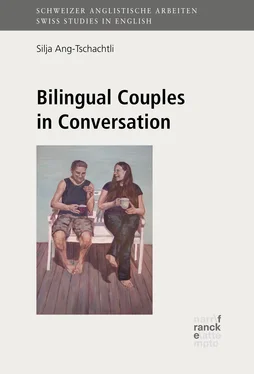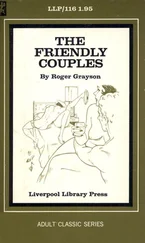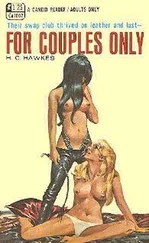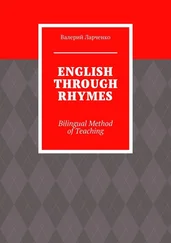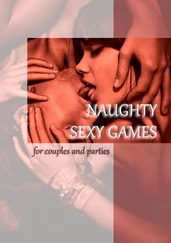
Silja Ang-Tschachtli
Bilingual Couples in Conversation
[bad img format]
Umschlaggestaltung: Martin Heusser, Zürich
Umschlagabbildung: Silja Ang-Tschachtli
Silja Ang-Tschachtli, ORCID: 0000-0002-3015-2246
Publiziert mit Unterstützung des Schweizerischen Nationalfonds zur Förderung der wissenschaftlichen Forschung.
DOI: https://doi.org/10.24053/9783772057632
© 2022 · Silja Ang-Tschachtli
Das Werk ist eine Open Access-Publikation. Es wird unter der Creative Commons Namensnennung – Weitergabe unter gleichen Bedingungen | CC BY-SA 4.0 ( https://creativecommons.org/licenses/by-sa/4.0/) veröffentlicht, welche die Nutzung, Vervielfältigung, Bearbeitung, Verbreitung und Wiedergabe in jeglichem Medium und Format erlaubt, solange Sie die/den ursprünglichen Autor/innen und die Quelle ordentlich nennen, einen Link zur Creative Commons-Lizenz anfügen und angeben, ob Änderungen vorgenommen wurden. Die in diesem Werk enthaltenen Bilder und sonstiges Drittmaterial unterliegen ebenfalls der genannten Creative Commons Lizenz, sofern sich aus der am Material vermerkten Legende nichts anderes ergibt. In diesen Fällen ist für die oben genannten Weiterverwendungen des Materials die Einwilligung des jeweiligen Rechteinhabers einzuholen.
Narr Francke Attempto Verlag GmbH + Co. KG
Dischingerweg 5 • D-72070 Tübingen
Internet: www.narr.deeMail: info@narr.de
ISSN 0080-7214
ISBN 978-3-7720-8763-9 (Print)
ISBN 978-3-7720-0171-0 (ePub)
I would like to dedicate this book to my own bilingual family: my husband Beng — the inspiration for my research — and our three children, Vincent, Jonathan, and Malina. Thank you for your love and patience, and for making me laugh every day. You are amazing.
In this sociolinguistic study, the speech and the modes of communication of ten bilingual couples were analysed, based on a corpus of in-depth interviews with both partners. My main aim was to draw a detailed picture of various areas pertaining to the communication between native speakers of English and Swiss partners who, despite being late bilinguals, have a high level of proficiency in English, their main couple language. Thus, important gaps in previous research on bilingual couples were filled, much of which is based on couples’ self-reports rather than their actual language use (Breger 1998; Khatib-Chahidi, Hill and Paton 1998) or concentrates on the female partner’s perspective (Heller and Lévy 1992). Studies on fluent couples have placed their focus on the discursive construction of a bilingual couple identity (Piller 2002a) or an individual bilingual identity (Gonçalves 2013). By contrast, I considered not only the couples’ reports on their linguistic practices and past experiences, but also analysed their language use during the interviews. Several areas of their speech were closely examined using qualitative as well as quantitative research methods, including the couples’ language choice, their language mixing, their manner of expressing emotions, their use of and reaction to swearwords, their attitudes towards their languages and cultures, and their production of humour and laughter. In addition, I investigated the influence of the bilinguals’ gender and mother tongue on various aspects of their language use. The analysis demonstrated that the couples’ language is predominantly English, with relatively little direct influence from the community language, Swiss German, and limited language mixing. Moreover, the bilinguals used only their main couple language to express emotions during the interviews, and also reported such a preference, in contrast to other bilinguals (Pavlenko 2008; Dewaele 2010). Nevertheless, the couples make use of their bilingualism in some very specific areas, for instance when coining neologisms and blended expressions, when using terms of endearment, when swearing, and when being humorous. Assimilation between the partners was evident in several areas, such as their language mixing behaviour, their swearing behaviour, and their attitudes; yet there was little indication of assimilation in the context of expressing emotions, or in the frequency and duration of laughter. At the same time, the participants’ gender and mother tongue were found to have a considerable influence on their expression of emotions, the number and type of language switches they used, the frequency of their swearing and the level offensiveness of their swearwords, as well as their laughter and their production and reception of humour. Thus, the analysis provides insights into the language practices of established bilingual couples, while also contributing to the fields of gender research and fluent sequential bilingualism.
List of transcriptiontranscription conventions
(adapted from Du Bois et al. 1993)
I would like to express my sincere gratitude to the many people who offered guidance in my research and writing, especially PD Dr Sarah Chevalier and Professor Dr Andreas Fischer. I am very grateful to Andreas Fischer for encouraging me to pursue my research interests and for providing me with valuable direction whenever needed; and to Sarah Chevalier, for supervising my PhD thesis, for sharing my interest in the subject of my research, and for providing excellent advice in my research and very helpful commentaries on my writing. I would also like to thank Professor Dr Daniel Schreier, for kindly offering to be a co-advisor on my thesis and for his helpful feedback, and Professor Dr Martin Heusser, for designing the book cover.
Special thanks go to Jane Dewhurst and Peter Stäuber, for proof-reading critically and providing thoughtful feedback on my writing, and to Martina Gubler, for her advice in the creation of the title image. I am also thankful to Katharina Gerhardt (Narr Francke) and Professor Dr Stephan Schmid (Phonetisches Laboratorium) for their help, as well as to Christine Benesch and Nicoletta Ravizza for their advice on statistics. Furthermore, I would like to thank the Swiss National Science Foundation (SNF) for financing the publication of this book.
I am also truly grateful to my family, especially to my wonderful parents, Irene und Stephan Tschachtli, for their love and support.
Last but not least, I want to express my deep appreciation to the ten bilingual couples who were the subject of my research. Thank you for devoting your time and for sharing so much about your private lives as bilingual couples and individuals. It is due to your readiness to tell your story and to engage in dialogue that this book was possible, and that my interest in the subject never faded.
1 Introduction
1.1 Bilingual couplebilingualcouples communication
After my first semester of studying English at the University of Zurich, I met an interesting young Australian while we were both travelling in Italy. We had a long-distance relationship for a few years, ultimately got married and settled in my home country, Switzerland. Being in a bilingual, bicultural relationship has enriched my life in more ways that I could have imagined, while at the same time presenting challengeschallengescultural in other areas. It has also opened my eyes to many particularities in the discourse and communication of bilingual, bicultural couples and sparked a great interest in this topic. As a bilingual couple, we are in contact with other bilingual couples, and observing other bilingual relationships and comparing their communication to ours has also made me aware of many shared characteristics. However, I rarely find our own situation or the bilingual relationships around us mirrored or adequately described in literature on bilingualism, which has intensified my urge to study bilingual couple communication.
Читать дальше
